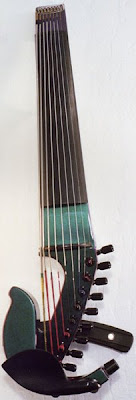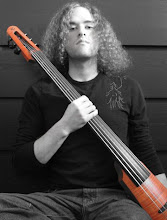
After emailing the luthier, John Jordan, I found out that it is true; and I think it looks awesome.
After quelling my disbelief, my next question was, "how's it tuned?" When I got my answer, I was surprised to find out that its highest string is pitched at A above the acoustic violin's E string. Reportedly Jordan wanted to make a high B string, but every string that he tried broke and he had to go with a high A instead. Besides this perfect fourth, the strings are tuned in fifths, as one would expect. So from high to low, we have: A E A D G C F Bb Eb.
Putting this into context, the E, A, D and G are the standard violin strings, the C is the same pitch as a viola's C, the F is a fourth above the cello's C, the Bb is a whole step below the cello's C, and the Eb is a half-step below the bass's E string (!).
Daaaaamn.
According to Ashworth, Jordan was commissioned to build this instrument by a member of the Berlin Philharmonic Orchestra. Interestingly enough, I found a forum post from June 2006 stating that violinist/composer D. Robert Burroughs was talking to Jordan about making one for him, so I have no idea who will play the one in the picture above.
Apparently, Burroughs wanted the lowest string to be an Ab, a fifth below the current low Eb, which would be pitched a minor third below a five-sting bass's low B (can you imagine that?). As Jordan wrote in an email to me, "I don't think we'll ever make a string go to low Ab at 13" length." No kidding, I'm shocked that he made a low Eb at 13" length, 'cuz that note is really, really low.
Maybe I'm letting the cat out of the bag, but he's planning to have three of these instruments ready at this January's NAMM show.
(Photo courtesy of John Jordan)
October 25, 2008
9-String Violin
Posted by Dean Capper at 11:07 PM 3 comments
Labels: 9-String Violin, Ashworth Electronics, Electric Violin, John Jordan
Sphere: Related ContentOctober 22, 2008
Reality Check
Here at Berklee, a pernicious idea is going around that string players can “get away” with certain things simply because our demand is far greater than our supply. This idea manifests itself both in attitudes towards professionalism and towards individual preparation.
An audition? Skip it and just show up to the first rehearsal. You’ll hear, "oh, you play the violin! Thank God you showed up!"
When Film Scoring and Production majors spot somebody with a cello case, they know that they'd better get that kid's phone number. They'll need him to play in their next recording session, and it'll be a long while before they stumble upon another cellist. Man, it's nice when folks are trackin' you down and askin' you to play.
Rehearsals? Only if you feel like going. "Oh, it's ok that you couldn't come to rehearsal, at least you're willing to play in the concert." Hmmm, one could get used to this.
Well don't.
Don't get used to it because the real word doesn't work like this. There, nobody will kiss your ass just because of the instrument you play, so you'd better be able to back yourself up with your chops like the saxophone, drum set, trumpet, etc. students are preparing to do. It's competitive and players who "got away" with things don't get hired. Wake up! Our shit stinks just like everyone else's.
October 19, 2008
Taking it Beyond the Basics
I started this blog because even though electric string instruments are becoming more and more common, using them to get satisfying sounds with effects pedals and an amplifier is not. I believe that one cause of this problem, as anyone who’s ever looked for equipment to buy has discovered, is that the world of, wait, strike that, universe of amplifiers and effects is insurmountably dizzying. Indeed, there are so many options, combinations and stylistic considerations that getting the sound that's inside your head out into the air can literally be a lifelong process of exploration.
Reaching this goal takes a lot of technical understanding even for electric guitarists and electric bassists, for whom most equipment was designed. So does that mean that we electronically-inexperienced string players are proverbially screwed? Well, let's just say that we'll have to do more homework than they will.
Do you wanna give up yet?
I find that several important considerations for intelligently selecting and combining* amps, effects pedals and an electric violin/viola/cello are largely ignored (at least on this here electric violin interweb), but that doesn't mean they're abstruse concepts. In fact, they make a lot of sense, but we just have to go looking for them in outside places. Try the Harmony Central Amps and Effects forums or articles available on well-known amplifier manufacturers' websites (like this one from Bogner Amps).
When searching for help via string instrument websites, all I've found were very general suggestions about how to get a "good sound" from your amp (several of which I now believe to be wrong) and a few suggestions about things to avoid. Unfortunately, "good sound" is such a broad term that it's useless.
In the beginning of one's "search for tone," "good sound" might only mean faithfully reproducing your instrument's unamplified signal. However, add some distortion and by that definition, "good" is exactly how it won't sound! So what's a body to do? Well, that's where this blog comes in. ;) Arrogance aside, it's really helpful to find a gearhead** guitarist and pick his/her brain; that's what I did.
In subsequent posts, I plan on writing several how-to guides, product comparisons, newsy things, hopefully an interview or two, and other important electronics topics uncommon to the string world. However, I want to be clear about what this blog will not be. This blog is not a superficial beginner's guide, an index of luthiers/manufacturers, a list of important players or anything else that's been thoroughly covered elsewhere. I will, however, devote space to products and players who I feel are not getting enough attention. My intention for this blog is to provide much more than just the simple information so commonly available, thus empowering serious players with the knowledge they need to take their sound beyond the basics.
*What do I mean by "intelligently selecting and combining" amplifiers, effects and electric instruments? I don't mean you're stupid if it doesn't make sense (because I know that things can become confusing). I mean: 1) you have a clear idea of what sound you want to get from your equipment and, 2) you're at least pretty sure you know which pieces will give it to you. That means having done some research on available products and knowing what equipment is used by the players you admire.
**Gearhead: a person whose compunction towards buying electronic musical equipment has reached dangerous levels, the amount of which is surpassed only by his/her knowledge of said equipment.
Does this make sense? If you have a question, something to add, or you just think I'm full of it, that's why a comment section is at the bottom of the page.







